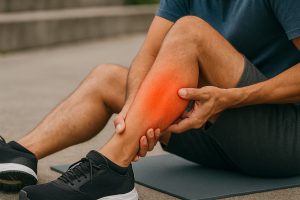One of the more common conditions people come to us for help with is calf pain. Many times, their calf feels very tight on the stairs or uphill walking.
They have discomfort after long walks. And often even struggle with cramps at rest. This starts to impact their day to day life and they want some help to get back to their normal activities.
Calf Muscle Tear Symptoms
One possible reason for calf pain is that you’ve a tear in the muscle. And you can tear a little <5% or you can tear it completely. So the severity of your symptoms will depend on the size of the tear.
Symptoms vary but often include:
Sudden Pain: You may feel something go then pain the back of your calf during activity, such as running or jumping. This pain can range from mild to severe.
Swelling: You can get swelling after a calf tear if your calf is very swollen it could be a DVT and needs immediate checking.
Bruising: Some people may notice bruising around the site of the injury. And often below the site of injury as the bleeding that will form into bruise pours down the leg from the original injury. Bruising often appears a few days after the initial injury.
Tenderness: The calf muscle may be tender to the touch, and you may feel discomfort or pain when applying pressure to the injured area.
Stiffness: Your calf may feel stiff, making it difficult to move your ankle or walk normally.
Weakness: You may experience weakness in the calf muscle, making it challenging to push off the ground when walking or engaging in physical activities.
Popping Sensation: Some individuals report hearing or feeling a popping or snapping sensation at the time of the injury. This can be a sign you have a more sever injury. Especially if you notice weakness after the pop.
Pulled Calf Muscle
A pulled calf, calf stain or calf tear all mean the same thing. It just means the muscle has a tear.
Severe Calf Tear
A severe strain with a complete or near-complete tear of the muscle. This typically results in intense pain, significant swelling, extensive bruising, and difficulty walking. If you suspect you have a calf muscle tear, it’s essential to seek medical attention for a proper diagnosis and treatment plan.
Are you suffering with pain or tightness down the back of your leg and into your calf? It could be a calf muscle tear.
This blog is going to focus on the symptoms of calf muscle tears and when you should seek treatment.

Should I go to a Physio with Calf Strain?
A good physio can assess your calf and the surrounding muscles, tendons along with the ankle joint and let you know what you’ve injured. They can explain what you’ve done and work with you to start making a tailored treatment plan that’s adjusted as you recover to make you heal in the best possible way and help you get back to your activity without your calf pulling again.
Can physio help with calf pain?
Lots of different conditions cause calf pain, and they all need very different treatments. It’s best to have a physio assessment and test the muscles and structures in your calf to see what exactly is causing your pain. Then you can get a more tailored approach and make sure you’re getting the right treatment to free up what’s tight, and get you the correct exercises to rebuild strength in the effected muscles.
What is the fastest way to relieve calf pain?
Stretching, ice and heat can all help with your calf pain.
Can physio help with tight calves?
There’s lots on hands on treatment, exercises and stretches that can all free up your calves. You have lots of muscles in your calves and they can be assessed and specific exercises prescribed to free up the tightness.
Calf strain recovery time
Calf tear recovery times vary based on how much of the muscle you’ve torn. But the average recovery time is 5-6 weeks. With good physio you can rebuild strength during this time. That way you’re back to full strength and good to go.
How to Stretch Your Two Biggest Calf Muscles
Here’s a video on how to stretch the 2 biggest muscles in your calf:
How to Heal an Injured Calf
Early doors stretching something that’s already torn is often a bad idea, as you’re pulling something that’s already ripped apart, but once its knitting back together some stretches to regain normal length are important and very helpful.
- Hands on treatment can help free up any areas of tightness.
- Strengthening exercises will help ensure sure the calf heals in a durable way. If you do completely rest it, your calf is slowly getting weaker all the time.
- Working with a good physio will help guide you which muscles are damaged. When to stretch. And how much exercise is safe to put through your injury at each point in your recovery, so you avoid setbacks and recover as quick a possible.
If you’re suffering from a calf tear and would like some help, Please give us a call or message on 07517421800.
Other Free Resources
Click Here To Read –How to Get Rid of Achilles Tendonitis
On social media? Follow us on Facebook or Instagram
